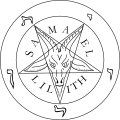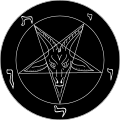Satanism

Satanism is a word that has several different meanings. It can describe different religions and philosophies.
Sometimes the word Satanism is just used to say that the person using it does not like a group, but the group themselves do not think of themselves as Satanists. Used like this, it is just used to say the speaker disapproves of a group. A lot of groups, like Pagans, or even Protestants have in the past been called Satanists by some people.
The word is often used by people who do not know much about Satanists, who think that Satanism means the worship of an evil being called Satan, and that Satanists want him to win in a war against good represented by "God". This is not true for most Satanists. For them, Satan is only a symbol for the freedom to be themselves, and the word Satan is used as a symbol for man's inner desires and for knowledge. These people read the writings of Anton LaVey and are sometimes called LaVeyan Satanists. There are several modern Satanic groups of different types, with the most well known being the Church of Satan, created in 1966 by Anton LaVey, who also wrote The Satanic Bible. Even though these types of satanists are atheists, meaning they do not believe in a higher being, they do practice magic. They believe that there is no afterlife.
Other types of Satanists do worship Satan. They are called theistic or traditional Satanists, because they believe their religion is older. They believe their religion is similar to that of Witches.
Some ethnoreligious groups were (and still are) falsely accused of being Satanists, for example: it was believed that Wiccans were Satanists because the god worshipped by them has horns (a trait commonly associated with Baphomet, a Satanic idol, when in fact it means fertility for Wiccans) and due to the demonization of paganism by Christians as well, the Kurdish Yazidi were also accused by Muslims and Christians alike of being Satanists because Melek Taûs, the central deity in Yazidism is similar to Iblis (the Islamic equivalent of Satan), and the Afro-Brazilian religions Umbanda and Candomblé were thought to be "Satanic" by Portuguese colonizers and Jesuit missionaries in Brazil and its deities (orishas) deemed to be "demons" purely based on prejudice and racism towards the African slaves and their culture.
Satanism Media
Stanislas de Guaita drew the original goat pentagram, which first appeared in the book La Clef de la Magie Noire in 1897. Adaptations of this inverted pentagram would later become synonymous with Baphomet.
The Sabbatic Goat, also known as the Goat of Mendes or Baphomet, as illustrated by Éliphas Lévi, has become one of the most common symbols of Satanism.[1]
The sigil of Baphomet, official insignia of the Church of Satan and LaVeyan Satanism
The headquarters of the Satanic Temple and Salem Art Gallery at Salem, Massachusetts
Other websites
LaVeyan Satanists
- Church of Satan: The Official Web Site Archived 2021-03-21 at the Wayback Machine
- First Satanic Church - Official Website Archived 2007-06-13 at the Wayback Machine
Theistic Satanists
- Diane Vera's site about Theistic Satanism Archived 2013-05-19 at the Wayback Machine
- Satan's Den





